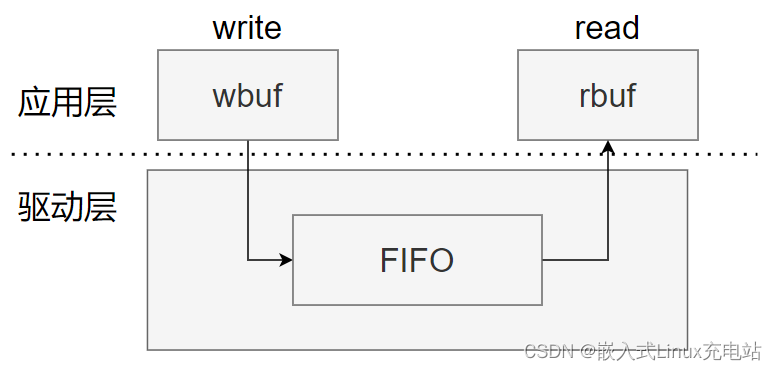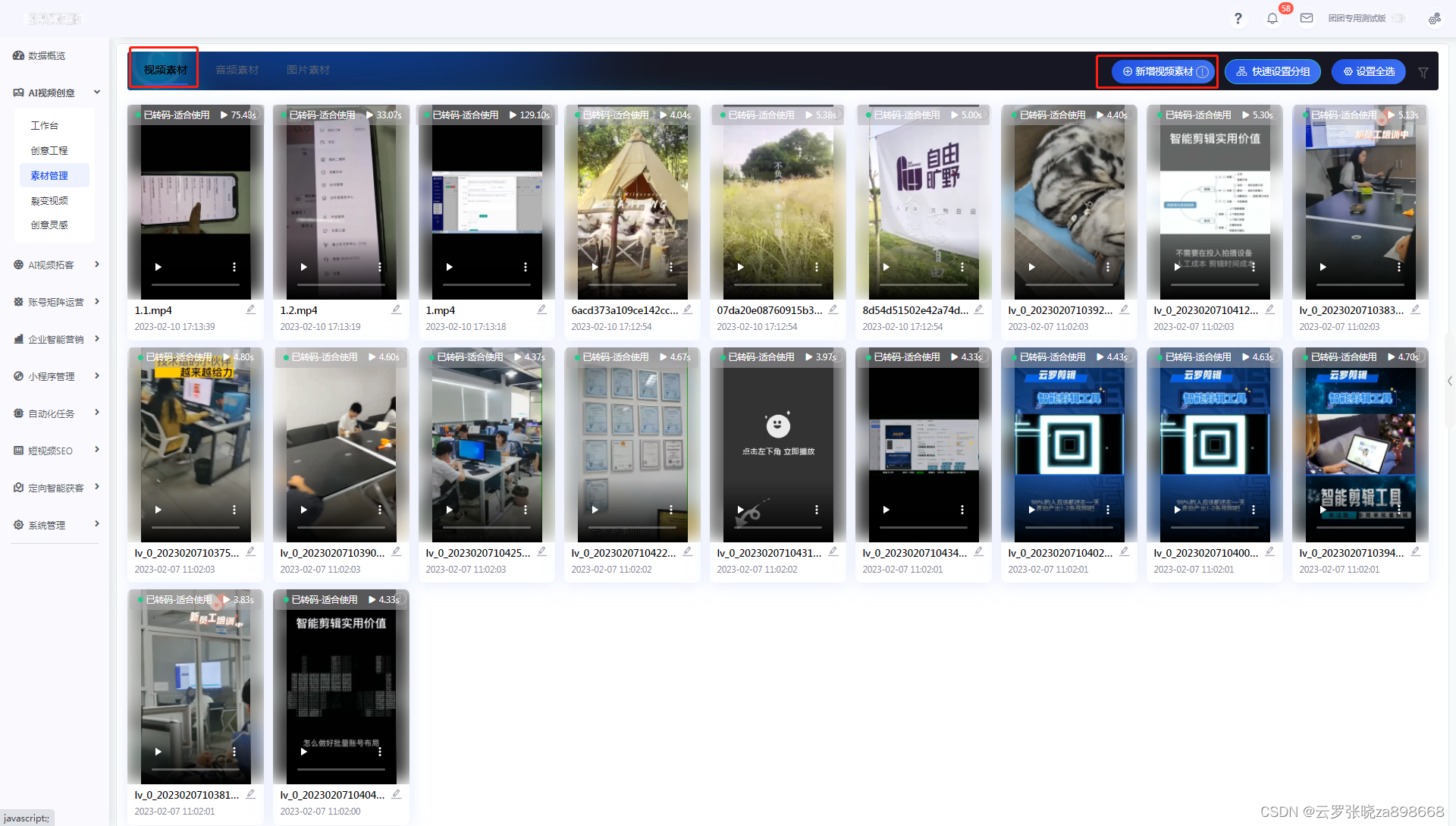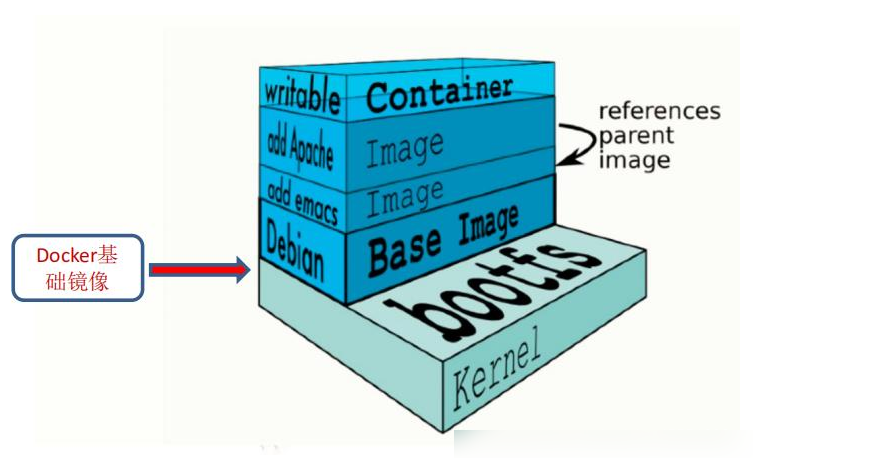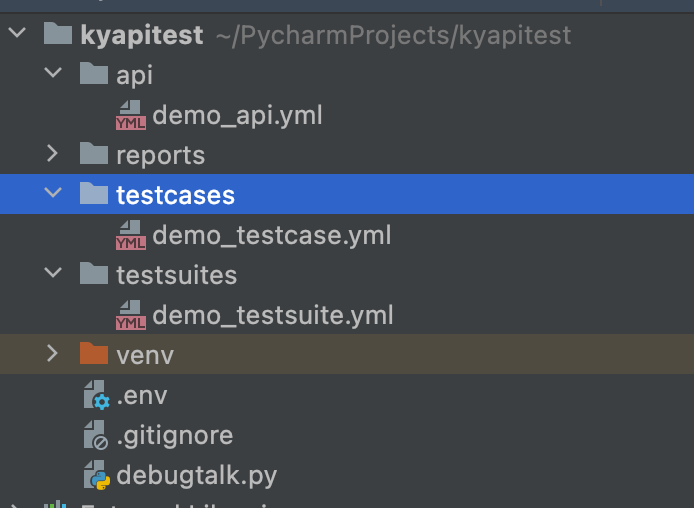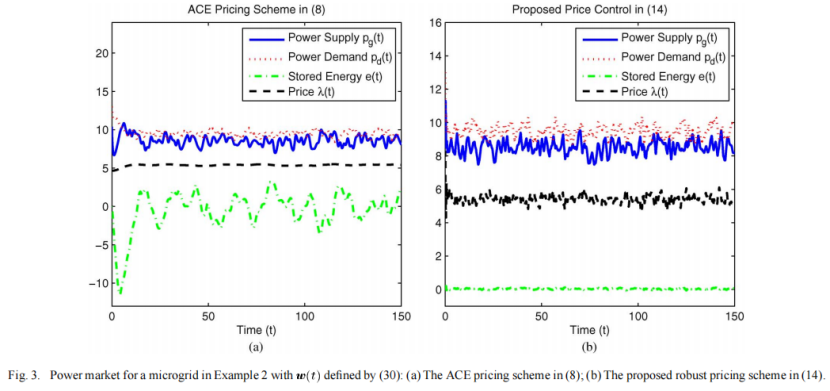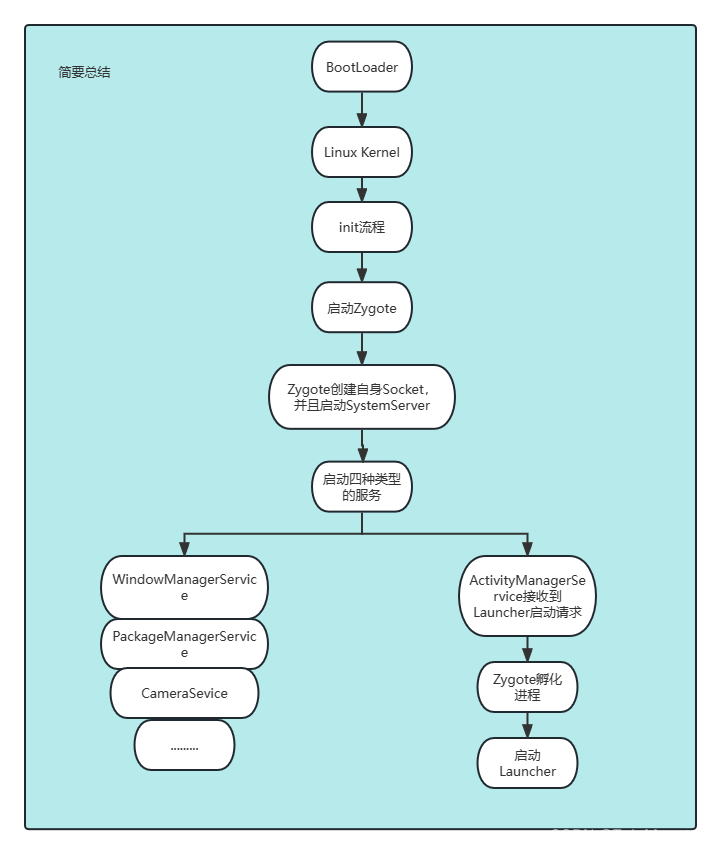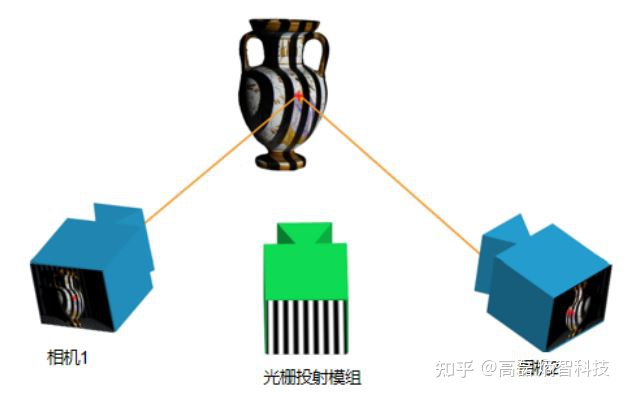最近yolov5用的多,发现确实好用,于是较深入学了一下。下面按照训练的流程梳理一下网络的结构,同时也是自己记一下便于后面查阅。
同时,我也查了一些关于yolov5网络结构介绍的资料,发现大多是v5.0,少数v6.0的,我是从v7.0开始用,所以对比v7.0的代码有出入,于是打算梳理一下yolov5s的v7.0版本的网络结构。
1、模型构建, 在train.py下关于模型的定义
# Model
check_suffix(weights, '.pt') # check weights
pretrained = weights.endswith('.pt')
"""定义模型的加载,是否是预训练模型还是配置文件格式的网络结构"""
if pretrained:
with torch_distributed_zero_first(LOCAL_RANK):
weights = attempt_download(weights) # download if not found locally
ckpt = torch.load(weights, map_location='cpu') # load checkpoint to CPU to avoid CUDA memory leak
model = Model(cfg or ckpt['model'].yaml, ch=3, nc=nc, anchors=hyp.get('anchors')).to(device) # create
exclude = ['anchor'] if (cfg or hyp.get('anchors')) and not resume else [] # exclude keys
csd = ckpt['model'].float().state_dict() # checkpoint state_dict as FP32
csd = intersect_dicts(csd, model.state_dict(), exclude=exclude) # intersect
model.load_state_dict(csd, strict=False) # load
LOGGER.info(f'Transferred {len(csd)}/{len(model.state_dict())} items from {weights}') # report
else:
"""不是预训练模型加载网络配置文件,通过cfg参数传入,可在models下找到,如models/yolov5s.yaml"""
model = Model(cfg, ch=3, nc=nc, anchors=hyp.get('anchors')).to(device) # create
根据上面的代码,我们看else后面的网络构建方法,这是以配置文件cfg传入,可以进行自定义和修改网络。可以看到 Model 有四个传入参数:
cfg 是网络配置文件
ch 是输入数据维度(通道)rgb图像
nc 是数据集类别数量
anchors 没细看,自查
然后去定义 Model 的位置,找到models.yolo,可以看到:
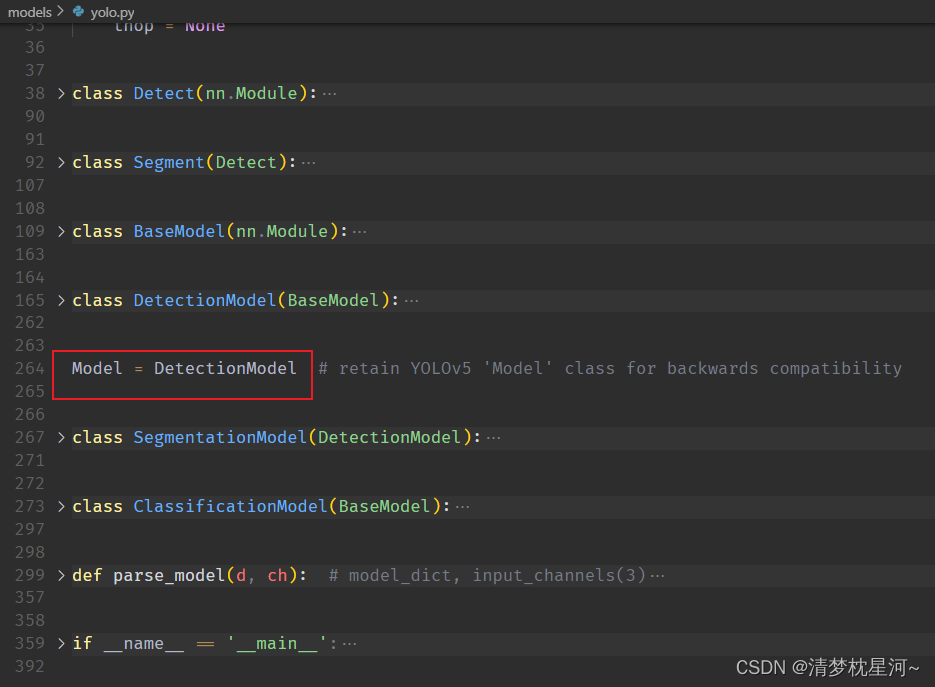
Model = DetectionModel,DetectionModel继承于BaseModel,BaseModel继承于torch的类nn.Model,基本上知道了模型的构建流程。
再根据参数cfg看一下具体的网络构建:
class DetectionModel(BaseModel):
# YOLOv5 detection model
def __init__(self, cfg='yolov5s.yaml', ch=3, nc=None, anchors=None): # model, input channels, number of classes
super().__init__()
if isinstance(cfg, dict):
self.yaml = cfg # model dict
else: # is *.yaml
import yaml # for torch hub
self.yaml_file = Path(cfg).name
with open(cfg, encoding='ascii', errors='ignore') as f:
self.yaml = yaml.safe_load(f) # model dict
# Define model
ch = self.yaml['ch'] = self.yaml.get('ch', ch) # input channels
if nc and nc != self.yaml['nc']:
LOGGER.info(f"Overriding model.yaml nc={self.yaml['nc']} with nc={nc}")
self.yaml['nc'] = nc # override yaml value
if anchors:
LOGGER.info(f'Overriding model.yaml anchors with anchors={anchors}')
self.yaml['anchors'] = round(anchors) # override yaml value
"""self.model是构建好的模型"""
self.model, self.save = parse_model(deepcopy(self.yaml), ch=[ch]) # model, savelist
self.names = [str(i) for i in range(self.yaml['nc'])] # default names
self.inplace = self.yaml.get('inplace', True)
上面的模型构建代码中,self.model是构建好的模型,可以发现网络构建的具体执行由函数parse_model()完成
self.model, self.save = parse_model(deepcopy(self.yaml), ch=[ch])
从上可以发现函数parse_model()的输入是cfg对应的配置文件,如yolov5s.yaml,ch表示初始输入数据维度(通道),具体看看函数是如何构建网络的,可以结合后面贴上的以yolov5s.yaml为例的内容看
def parse_model(d, ch): # model_dict, input_channels(3)
# Parse a YOLOv5 model.yaml dictionary
LOGGER.info(f"\n{'':>3}{'from':>18}{'n':>3}{'params':>10} {'module':<40}{'arguments':<30}")
anchors, nc, gd, gw, act = d['anchors'], d['nc'], d['depth_multiple'], d['width_multiple'], d.get('activation')
"""anchors, nc, gd, gw分别是yolov5s的
nc: 80 # number of classes
depth_multiple: 0.33 # model depth multiple
width_multiple: 0.50 # layer channel multiple
anchors:
- [10,13, 16,30, 33,23] # P3/8
- [30,61, 62,45, 59,119] # P4/16
- [116,90, 156,198, 373,326] # P5/32
"""
if act:
Conv.default_act = eval(act) # redefine default activation, i.e. Conv.default_act = nn.SiLU()
LOGGER.info(f"{colorstr('activation:')} {act}") # print
na = (len(anchors[0]) // 2) if isinstance(anchors, list) else anchors # number of anchors
no = na * (nc + 5) # number of outputs = anchors * (classes + 5)
"""开始构建网络"""
layers, save, c2 = [], [], ch[-1] # layers, savelist, ch out
for i, (f, n, m, args) in enumerate(d['backbone'] + d['head']): # from, number, module, args
"""
d['backbone'] + d['head']表示yolov5s.yaml的backbone和head的信息
f, n, m, args分别对应如下列表中每个单元的信息,f表示从哪一层输入,n表示该模块的数量,m表示模块名称,如Conv,args表示该模块数据进入的具体信息,[64, 6, 2, 2],64表示输出维度,6表示卷积核大小,2表示卷积步长,第二个2看具体定义
[[-1, 1, Conv, [64, 6, 2, 2]], # 0-P1/2
[-1, 1, Conv, [128, 3, 2]], # 1-P2/4
[-1, 3, C3, [128]],
[-1, 1, Conv, [256, 3, 2]], # 3-P3/8
[-1, 6, C3, [256]],
[-1, 1, Conv, [512, 3, 2]], # 5-P4/16
[-1, 9, C3, [512]],
[-1, 1, Conv, [1024, 3, 2]], # 7-P5/32
[-1, 3, C3, [1024]],
[-1, 1, SPPF, [1024, 5]], # 9
]
"""
m = eval(m) if isinstance(m, str) else m # eval strings
for j, a in enumerate(args):
with contextlib.suppress(NameError):
args[j] = eval(a) if isinstance(a, str) else a # eval strings
n = n_ = max(round(n * gd), 1) if n > 1 else n # depth gain
"""
m表示模块名称,通用的模块放一块便于设置输入输出的参数信息c1,c2
"""
if m in {
Conv, GhostConv, Bottleneck, GhostBottleneck, SPP, SPPF, DWConv, MixConv2d, Focus, CrossConv,
BottleneckCSP, C3, C3TR, C3SPP, C3Ghost, nn.ConvTranspose2d, DWConvTranspose2d, C3x}:
"""
c1,c2表示该模块的数据输入输出维度,ch[f]=ch[-1]=3,具体看前面ch定义,表示数据输入维度;args[0]对应上面的64,说明该层输出的数据维度为64
"""
c1, c2 = ch[f], args[0]
if c2 != no: # if not output
c2 = make_divisible(c2 * gw, 8)
args = [c1, c2, *args[1:]]
if m in {BottleneckCSP, C3, C3TR, C3Ghost, C3x}:
args.insert(2, n) # number of repeats
n = 1
elif m is nn.BatchNorm2d:
args = [ch[f]]
elif m is Concat:
c2 = sum(ch[x] for x in f)
# TODO: channel, gw, gd
elif m in {Detect, Segment}:
args.append([ch[x] for x in f])
if isinstance(args[1], int): # number of anchors
args[1] = [list(range(args[1] * 2))] * len(f)
if m is Segment:
args[3] = make_divisible(args[3] * gw, 8)
elif m is Contract:
c2 = ch[f] * args[0] ** 2
elif m is Expand:
c2 = ch[f] // args[0] ** 2
else:
c2 = ch[f]
"""
m_ 把模块m (如Conv)和 m 的输入参数 args 进行实例化并通过nn.sequential来把模块连接起来构建成网络
"""
m_ = nn.Sequential(*(m(*args) for _ in range(n))) if n > 1 else m(*args) # module
t = str(m)[8:-2].replace('__main__.', '') # module type
np = sum(x.numel() for x in m_.parameters()) # number params
m_.i, m_.f, m_.type, m_.np = i, f, t, np # attach index, 'from' index, type, number params
LOGGER.info(f'{i:>3}{str(f):>18}{n_:>3}{np:10.0f} {t:<40}{str(args):<30}') # print
save.extend(x % i for x in ([f] if isinstance(f, int) else f) if x != -1) # append to savelist
layers.append(m_)
if i == 0:
ch = []
ch.append(c2)
"""ch用于记录各层的输出维度,所以上面每次循环时的ch[f]=ch[-1]都会等于上一层的输出维度,可以保证数据维度对应"""
return nn.Sequential(*layers), sorted(save)
"""
最终由layers.append(m_)把各个模块实例化连接后再通过nn.Sequential(*layers)搭建成网络,由此得到model,完成模型构建
"""
下面是yolov5s.yaml的具体内容:
# YOLOv5 🚀 by Ultralytics, GPL-3.0 license
# Parameters
nc: 80 # number of classes
depth_multiple: 0.33 # model depth multiple
width_multiple: 0.50 # layer channel multiple
anchors:
- [10,13, 16,30, 33,23] # P3/8
- [30,61, 62,45, 59,119] # P4/16
- [116,90, 156,198, 373,326] # P5/32
# YOLOv5 v6.0 backbone
backbone:
# [from, number, module, args]
[[-1, 1, Conv, [64, 6, 2, 2]], # 0-P1/2
[-1, 1, Conv, [128, 3, 2]], # 1-P2/4
[-1, 3, C3, [128]],
[-1, 1, Conv, [256, 3, 2]], # 3-P3/8
[-1, 6, C3, [256]],
[-1, 1, Conv, [512, 3, 2]], # 5-P4/16
[-1, 9, C3, [512]],
[-1, 1, Conv, [1024, 3, 2]], # 7-P5/32
[-1, 3, C3, [1024]],
[-1, 1, SPPF, [1024, 5]], # 9
]
# YOLOv5 v6.0 head
head:
[[-1, 1, Conv, [512, 1, 1]],
[-1, 1, nn.Upsample, [None, 2, 'nearest']],
[[-1, 6], 1, Concat, [1]], # cat backbone P4
[-1, 3, C3, [512, False]], # 13
[-1, 1, Conv, [256, 1, 1]],
[-1, 1, nn.Upsample, [None, 2, 'nearest']],
[[-1, 4], 1, Concat, [1]], # cat backbone P3
[-1, 3, C3, [256, False]], # 17 (P3/8-small)
[-1, 1, Conv, [256, 3, 2]],
[[-1, 14], 1, Concat, [1]], # cat head P4
[-1, 3, C3, [512, False]], # 20 (P4/16-medium)
[-1, 1, Conv, [512, 3, 2]],
[[-1, 10], 1, Concat, [1]], # cat head P5
[-1, 3, C3, [1024, False]], # 23 (P5/32-large)
[[17, 20, 23], 1, Detect, [nc, anchors]], # Detect(P3, P4, P5)
]
下面是我根据查的结构图在yolov5s.yaml的基础上做的修改
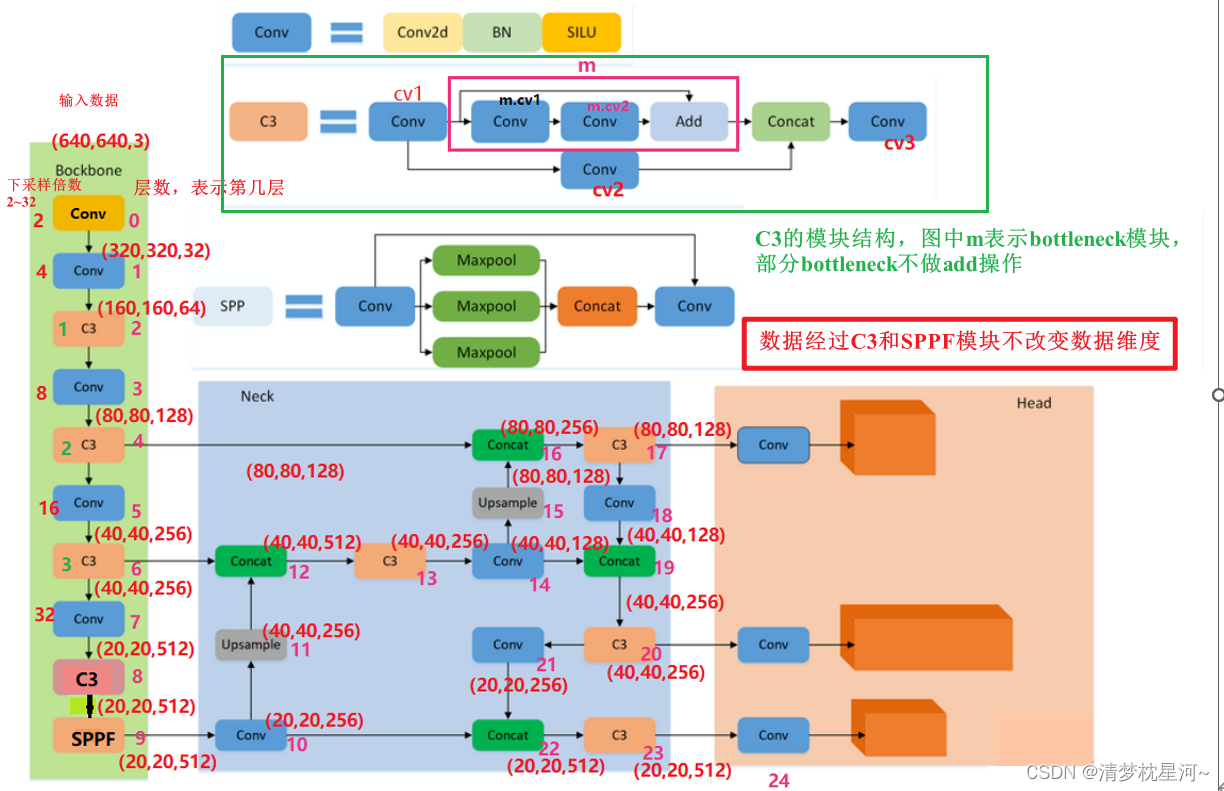
可以看出backbone部分网络做下采样操作,在第四层、第六层和第九层分别对应8,16,32倍下采样的输出数据进行后续neck处理,neck部分先是第十层做上采样到4倍下采样再继续做下采样,相当于做了两遍数据融合
